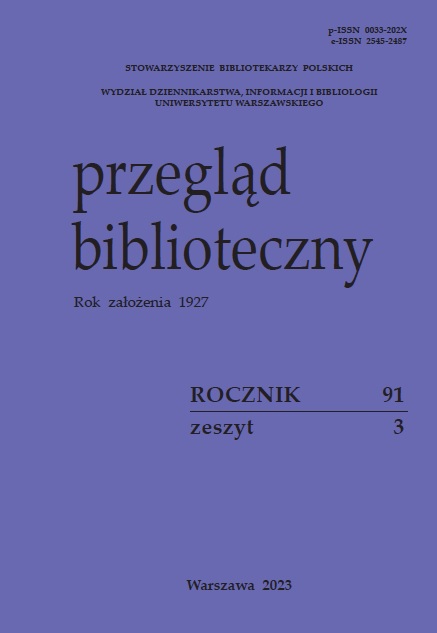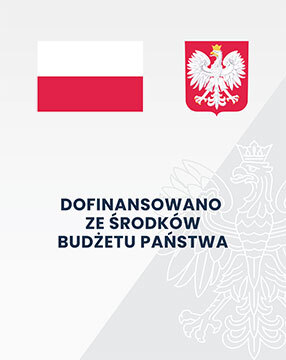SAFETY AND PROTECTION OF MINOR LIBRARY USERS IN THE LIGHT OF THE SO-CALLED “KAMILEK’S ACT”
DOROTA GRABOWSKA
https://orcid.org/0000-0002-2727-6942
Afiliacja: Faculty of Journalism, Information and Book Studies; University of Warsaw, Polska
Abstrakt
Purpose – The aim of this article is to present the role of school and public libraries in meeting the need for user safety in light of the so-called “Kamilek’s Act”. Methods – Guidelines and templates for developing standards for the protection of minors on the gov.pl website and the Empowering Children Foundation website, as well as standards developed by provincial libraries in Poland, were analyzed. Conclusions – Libraries are established to meet user needs, including the need for safety. The so-called “Kamilek’s Act” introduced the requirement to develop standards for the protection of minors, which emphasized the obligation to ensure the safety of children and young people. When implementing these standards, libraries define, among other things: principles for ensuring safe relationships between minors and staff; rules and procedures for intervening in situations of suspected abuse or information about abuse of a minor; requirements for safe relationships between minors, particularly prohibited behavior; rules for using electronic devices with internet access; and procedures for protecting children from harmful content and threats online and otherwise. The standards take into account the situation of children with disabilities and children with special educational needs. These are important areas of library activity and can serve as safe spaces for users.
Bibliografia
Fundacja Dajemy Dzieciom Siłę (2025, June 5). Co robimy? Wprowadzamy Stan-dardy ochrony małoletnich. https://fdds.pl/co-robimy.html#standardy-ochrony-dzieci
Fundacja Dajemy Dzieciom Siłę (2025, June 5). Standardy ochrony dzieci. https://standardy.fdds.pl/standardy
Główny Urząd Statystyczny (2025, June 5). Biblioteki publiczne w 2024 r. https://stat.gov.pl/obszary-tematyczne/kultura-turystyka-sport/kultura/biblioteki-publiczne-w-2024-r-,14,9.html
Göthlin M., Widstrand T (2012), Porozumienie bez przemocy: zarządzanie konfliktami w edukacji zrozumienie mimo różnic.
Koźmiński A.K. & Piotrowski W. (Ed.) (1999). Zarządzanie. Teoria i praktyka. Wydaw. Naukowe PWN.
Młode głowy. Raport z badania dotyczącego zdrowia psychicznego, poczucia własnej wartości i sprawczości młodych (2023), Fundacja UNAWEZA.
Rosenberg M. B. (2013), W świecie porozumienia bez przemocy. Praktyczne narzędzia do budowania więzi i komunikacji, Wydaw. MiND.
Serwis Rzeczypospolitej Polskiej gov.pl (2025, June 2), Standardy ochrony dzieci – wytyczne. https://www.gov.pl/web/sprawiedliwosc/standardy-ochrony-maloletnich---wytyczne
Stradomska M. (2024). Dobrostan psychiczny dzieci. Meritum, No. 2 (73), pp. 22-27.
Tokarska, A. (Ed.). (2013). Bibliotekarstwo. Wydaw. Stowarzyszenia Bibliotekarzy Polskich.
Tubylewicz K. & Diduszko-Zyglewska A. (Ed.). Szwecja czyta. Polska czyta. Wy-daw. Krytyki Politycznej.
Ustawa z dnia 13 maja 2016 r. o przeciwdziałaniu zagrożeniom przestępczością na tle seksualnym i ochronie małoletnich. Dz. U. z 2024 r. poz. 560. (Act of 13 May 2016 on Counteracting the Threat of Sexual Crime and the Protection of Minors. Journal of Laws of 2024, item 560.)
Wojciechowski J. (2014), Biblioteki w nowym otoczeniu. Wydaw. Stowarzyszenia Bibliotekarzy Polskich.
Wytyczne IFLA dla bibliotek obsługujących dzieci w wieku 0-18 lat (2022). Wydaw-nictwo Naukowe i Edukacyjne Stowarzyszenia Bibliotekarzy Polskich.
Zybert E.B. (2017), Pomysły na biblioteki XXI wieku. W A. Mierzecka, E.B. Zybert (Ed.) Instytucje kultury jako ośrodki życia społecznego. Wydaw. Stowarzyszenia Bibliotekarzy Polskich, pp. 14-46.
https://orcid.org/0000-0002-2727-6942
Afiliacja: Faculty of Journalism, Information and Book Studies; University of Warsaw, Polska
Biogram:
DOROTA GRABOWSKA, PhD, works at the Department of Research on Libraries and Other Cultural Institutions at the Faculty of Journalism, Information and Book Studies of the University of Warsaw. Her research interests focus around issues related to the organization and operation of public and school libraries. She is particularly interested in the forms and methods of working with the user in the library. Since 2013, she serves as the secretary of the “Przegląd Biblioteczny” (“Library Review”). Since 2003, she has been the secretary of the “Poradnik Bibliotekarza” (“Librarian’s Guide”), as well as part of the editorial team of the “Biblioteczka Poradnika Bibliotekarza” (“Librarian’s Guide Library”) series. She is the author of articles: “Ewolucja zadań nauczycieli bibliotekarzy w dydaktyce szkolnej” (“The evolution of librarian teachers’ tasks in school teaching”) Studia o Książce i Informacji (Studies about the book and information), 2018, No. 37, pp. 93-105. Animacja kultury w bibliotekach publicznych w Polsce (Cultural animation in public libraries in Poland). W: Litteris et Amicitia. Warszawa: Wydawnictwo Naukowe i Edukacyjne Stowarzyszenia Bibliotekarzy Polskich, 2023, s. 289-300; Biblioteka jako podmiot uczestniczący w procesach marketingu terytorialnego (A library as subject participating in territorial marketing processes) W: Marketing w działalności bibliotecznej (Library marketing) Warszawa: Wydawnictwo Naukowe i Edukacyjne Stowarzyszenia Bibliotekarzy Polskich, 2023, s. 574-585.
Autor składa oświadczenie o oryginalności przesłanego tekstu, a w umowie wydawniczej przenosi na rzecz Wydawcy nieodpłatnie majątkowe prawa autorskie w zakresie jednorazowego opublikowania dzieła.
CC BY-NC-ND 4.0 Uznanie autorstwa - Użycie niekomercyjne - Bez utworów zależnych 4.0 Międzynarodowe




